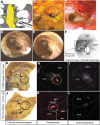Creating a stem cell niche in the inner ear using self-assembling peptide amphiphiles
- PMID: 29284013
- PMCID: PMC5746215
- DOI: 10.1371/journal.pone.0190150
Creating a stem cell niche in the inner ear using self-assembling peptide amphiphiles
Abstract
The use of human embryonic stem cells (hESCs) for regeneration of the spiral ganglion will require techniques for promoting otic neuronal progenitor (ONP) differentiation, anchoring of cells to anatomically appropriate and specific niches, and long-term cell survival after transplantation. In this study, we used self-assembling peptide amphiphile (PA) molecules that display an IKVAV epitope (IKVAV-PA) to create a niche for hESC-derived ONPs that supported neuronal differentiation and survival both in vitro and in vivo after transplantation into rodent inner ears. A feature of the IKVAV-PA gel is its ability to form organized nanofibers that promote directed neurite growth. Culture of hESC-derived ONPs in IKVAV-PA gels did not alter cell proliferation or viability. However, the presence of IKVAV-PA gels increased the number of cells expressing the neuronal marker beta-III tubulin and improved neurite extension. The self-assembly properties of the IKVAV-PA gel allowed it to be injected as a liquid into the inner ear to create a biophysical niche for transplanted cells after gelation in vivo. Injection of ONPs combined with IKVAV-PA into the modiolus of X-SCID rats increased survival and localization of the cells around the injection site compared to controls. Human cadaveric temporal bone studies demonstrated the technical feasibility of a transmastoid surgical approach for clinical intracochlear injection of the IKVAV-PA/ONP combination. Combining stem cell transplantation with injection of self-assembling PA gels to create a supportive niche may improve clinical approaches to spiral ganglion regeneration.
Conflict of interest statement
Figures







Similar articles
-
An engineered three-dimensional stem cell niche in the inner ear by applying a nanofibrillar cellulose hydrogel with a sustained-release neurotrophic factor delivery system.Acta Biomater. 2020 May;108:111-127. doi: 10.1016/j.actbio.2020.03.007. Epub 2020 Mar 7. Acta Biomater. 2020. PMID: 32156626 Free PMC article.
-
Self-assembling peptide amphiphile promotes plasticity of serotonergic fibers following spinal cord injury.J Neurosci Res. 2010 Nov 1;88(14):3161-70. doi: 10.1002/jnr.22472. J Neurosci Res. 2010. PMID: 20818775 Free PMC article.
-
A tenascin-C mimetic peptide amphiphile nanofiber gel promotes neurite outgrowth and cell migration of neurosphere-derived cells.Acta Biomater. 2016 Jun;37:50-8. doi: 10.1016/j.actbio.2016.04.010. Epub 2016 Apr 7. Acta Biomater. 2016. PMID: 27063496 Free PMC article.
-
Building an Artificial Stem Cell Niche: Prerequisites for Future 3D-Formation of Inner Ear Structures-Toward 3D Inner Ear Biotechnology.Anat Rec (Hoboken). 2020 Mar;303(3):408-426. doi: 10.1002/ar.24067. Epub 2019 Jan 28. Anat Rec (Hoboken). 2020. PMID: 30635991 Free PMC article. Review.
-
Cell replacement therapy in the inner ear.Stem Cells Dev. 2006 Jun;15(3):449-59. doi: 10.1089/scd.2006.15.449. Stem Cells Dev. 2006. PMID: 16846380 Review.
Cited by
-
Three-Dimensional Otic Neuronal Progenitor Spheroids Derived from Human Embryonic Stem Cells.Tissue Eng Part A. 2021 Feb;27(3-4):256-269. doi: 10.1089/ten.TEA.2020.0078. Epub 2020 Aug 7. Tissue Eng Part A. 2021. PMID: 32580647 Free PMC article.
-
An engineered three-dimensional stem cell niche in the inner ear by applying a nanofibrillar cellulose hydrogel with a sustained-release neurotrophic factor delivery system.Acta Biomater. 2020 May;108:111-127. doi: 10.1016/j.actbio.2020.03.007. Epub 2020 Mar 7. Acta Biomater. 2020. PMID: 32156626 Free PMC article.
-
Self-Assembled Peptide Nanostructures for ECM Biomimicry.Nanomaterials (Basel). 2022 Jun 22;12(13):2147. doi: 10.3390/nano12132147. Nanomaterials (Basel). 2022. PMID: 35807982 Free PMC article. Review.
-
Surgical Transcanal Procedure for Injection of Cells and Substances into the Human Cochlear Modiolus.Otol Neurotol. 2025 Apr 1;46(4):476-484. doi: 10.1097/MAO.0000000000004463. Epub 2025 Feb 20. Otol Neurotol. 2025. PMID: 39972988 Free PMC article.
-
Multifunctional Self-Assembled Peptide Hydrogels for Biomedical Applications.Polymers (Basel). 2023 Feb 25;15(5):1160. doi: 10.3390/polym15051160. Polymers (Basel). 2023. PMID: 36904404 Free PMC article. Review.
References
-
- Wilson BS, Dorman MF, Woldorff MG, Tucci DL. Cochlear implants matching the prosthesis to the brain and facilitating desired plastic changes in brain function. Prog Brain Res. 1st ed. Elsevier B.V.; 2011;194: 117–29. doi: 10.1016/B978-0-444-53815-4.00012-1 - DOI - PMC - PubMed
-
- Wilson BS, Dorman MF. Cochlear implants: A remarkable past and a brilliant future. Hear Res. 2008;242: 3–21. doi: 10.1016/j.heares.2008.06.005 - DOI - PMC - PubMed
-
- Webster DB, Webster M. Multipolar spiral ganglion neurons following organ of Corti loss. Brain Res. 1982;244: 356–359. doi: 10.1016/0006-8993(82)90097-X - DOI - PubMed
-
- Chen W, Jongkamonwiwat N, Abbas L, Eshtan SJ, Johnson SL, Kuhn S, et al. Restoration of auditory evoked responses by human ES-cell-derived otic progenitors. Nature. Nature Publishing Group; 2012;490: 278–282. doi: 10.1038/nature11415 - DOI - PMC - PubMed
-
- Corrales C, Pan L, Li H, Liberman MC, Heller S, Edge ASB. Engraftment and differentiation of embryonic stem cell–derived neural progenitor cells in the cochlear nerve trunk: Growth of processes into the organ of corti. J Neurobiol. 2006;66: 489–500. doi: 10.1002/neu - DOI - PMC - PubMed
Publication types
MeSH terms
Substances
Grants and funding
LinkOut - more resources
Full Text Sources
Other Literature Sources
Research Materials

